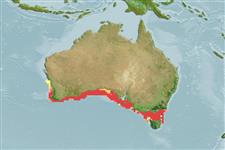Elasmobranchii (haaien en roggen) (sharks and rays) >
Orectolobiformes (Carpet sharks) >
Parascylliidae (Collared carpet sharks)
Etymology: Parascyllium: para (Gr.), near, i.e., presumed to be related to Scyliorhinus (now in Scyliorhinidae): skylion, Greek for dogfish or small shark. (See ETYFish); variolatum: Latin for spotted, referring to white spots that sprinkle body. (See ETYFish).
More on author: Duméril.
Environment: milieu / climate zone / depth range / distribution range
Ecologie
marien demersaal; diepte ? - 180 m (Ref. 6871). Temperate; 37°S - 42°S, 113°E - 150°E (Ref. 54701)
Eastern Indian Ocean: endemic to Australia.
Grootte / Gewicht / Leeftijd
Maturity: Lm ? range ? - ? cm
Max length : 91.0 cm TL mannelijk / geslacht onbekend; (Ref. 247)
Found on the continental shelf at depths of inshore down to about 180 meters. Apparently occurs in a variety of habitats, including sandy bottom, on rocky reefs, in beds of kelp, and in seagrass beds, details of it ecology is, however, virtually unknown (Ref. 43278). Oviparous (Ref. 6871).
Levenscyclus en paargedrag
Maturiteit | Voortplanting | Paaien | Eieren | Fecunditeit | Larven
Oviparous, paired eggs are laid. Embryos feed solely on yolk (Ref. 50449).
Compagno, L.J.V., 1984. FAO Species Catalogue. Vol. 4. Sharks of the world. An annotated and illustrated catalogue of shark species known to date. Part 1 - Hexanchiformes to Lamniformes. FAO Fish. Synop. 125(4/1):1-249. Rome, FAO. (Ref. 247)
Status op de Rode Lijst van het IUCN (Ref. 130435)
Gevaar voor de mens
Harmless
Gebruik door de mens
Visserij: van geen belang
Meer informatie
Leeftijd/Grootte
Groei
Lengte-gewicht
Lengte-lengte
Lengtefrequenties
Morfometrie
Morfologie
Larven
Larvale populatiedynamiek
Rekrutering
Abundantie
BRUVS
ReferentiesAquacultuurAquacultuurprofielKweeklijnenGeneticaElectrophoresesErfelijkheidZiektesVerwerkingNutrientsMassaconversie
Tools
Speciale rapporten
Download XML
Internetbronnen
Estimates based on models
Preferred temperature (Ref.
123201): 14.6 - 18.3, mean 16.8 °C (based on 174 cells).
Fylogenetische diversiteitsindex (Ref.
82804): PD
50 = 0.5352 [Uniqueness, from 0.5 = low to 2.0 = high].
Bayesian length-weight: a=0.00389 (0.00180 - 0.00842), b=3.12 (2.94 - 3.30), in cm total length, based on all LWR estimates for this body shape (Ref.
93245).
Trofisch niveau (Ref.
69278): 3.8 ±0.6 se; based on size and trophs of closest relatives
Weerstandsvermogen (Ref.
120179): laag, minimale populatieverdubbelingstijd 4,5-14 jaar (Fec assumed to be <100).
Fishing Vulnerability (Ref.
59153): High vulnerability (56 of 100).
Nutrients (Ref.
124155): Calcium = 12.1 [2.4, 53.3] mg/100g; Iron = 0.254 [0.069, 0.719] mg/100g; Protein = 18.9 [16.8, 20.8] %; Omega3 = 0.41 [0.18, 0.89] g/100g; Selenium = 12.8 [3.9, 33.7] μg/100g; VitaminA = 9.56 [2.96, 29.00] μg/100g; Zinc = 0.422 [0.206, 0.758] mg/100g (wet weight);
